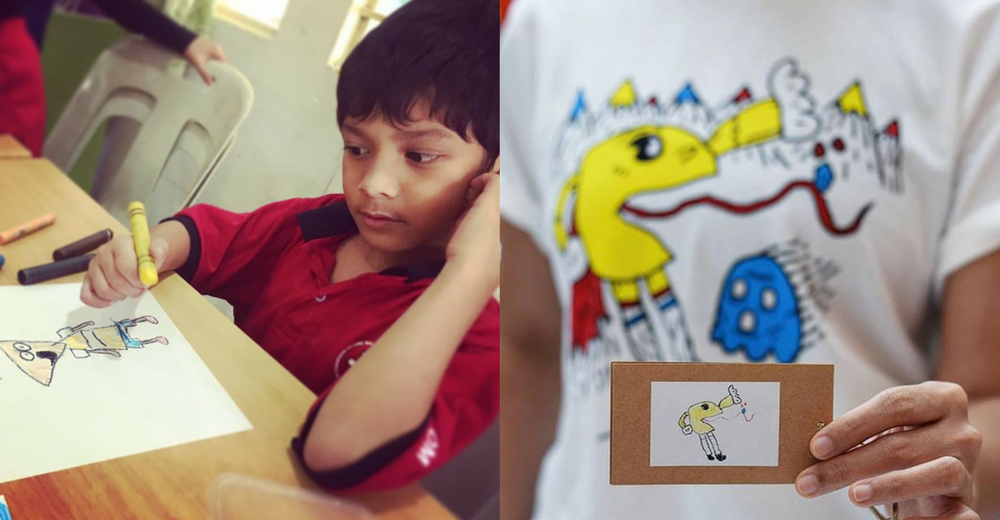Robin and Andy initially started their business focusing solely on shirt printing services. They invested in the knowledge and art of silk screening to create SPCO (Shirt Printing CO) in order to produce their own clothing line that would portray its own story with each design.
It wasn’t until the middle of 2016 when they got an inspiration for where to take their venture.
When the Singaporean Prime Minister and his wife, Ho Ching visited the White House, she was using an $11 pouch made by Pathlight, a school in Singapore for children with autism.
This planted a seed of an idea for SPCO to use art by those with autism in their printing service.
Getting The Team Together
The team now joined by Julian first participated in MaGIC’s Accelerator Program Cohort 03 Social Enterprise Track to kickstart their idea. Through the 4 months course, they were able to gain the right knowledge and skills to prepare themselves to work as a socially driven enterprise.
They were also able to meet other startups that helped with their cause. Some of them were Music and Me who introduced them to the autism community, Grow the Goose who encouraged them to organise art classes for the kids and Foodbike who connected them to reliable partners.

SPCO approached NASOM (National Autism Society of Malaysia) with their idea of empowering autistic children with art and reusing their drawings to make shirt prints.
“With strong encouragement and a common goal to spread awareness regarding the autism spectrum disorder, we’re collaborating with NASOM where 30% of the proceeds will be channeled back to the organisation to further develop the kids’ growth and learning,” said Julian.
Besides the trio, SPCO also works closely with the founder of Artisikong Kaabatan Philippines, Anna Karina Jardin who shares the same goal of empowering autistic children.
Bringing The Artwork To Life
According to SPCO, the entire process of designing a shirt and producing it takes about 1 and a half months with the most time spent on enhancing the sketch and second on the printing of the shirt.
How it works is by taking the drawings from a child with autism and then hiring freelance designers to help enhance them while maintaining the base image.
“To produce their best designs, we allow designers to have more time to fully express their creativity. For the shirt printing, we try to ensure our shirts prints possess a certain level of quality before we allow them to be sold,” said Julian.

The way SPCO conducts their art classes with the children is done through three stages.
- First Visit: To observe the classes and get to know the children’s interests and behaviour.
- Second Visit: Conduct doodling sessions using pencils, pens and crayons.
- Third Visit: Teaching them by allowing them to observe and follow our instructions as we create our masterpieces together one step at a time with crayons, poster colours and paper crafts.
Afterwards, SPCO will switch to different NASOM centers and repeat the second and third stages.

When it comes to their designers, SPCO said that most of them are crowd-sourced so they welcome all designers who are willing to join in.
They’re always looking for fresh designers and aspiring ones to join their cause. They are also able to serve as a platform for the designers to promote their art and produce unique designs each time.

Currently, their shirts can be found online as well as during special events where SPCO is present.
Their shirt prices are RM68 including delivery. At the moment, they are looking for retail outlets who would be willing to feature their products in store.
The Community
Julian shared that prior to starting SPCO, they had no experience dealing with the autism community but they believe that it is no reason to not get involved.
“It struck us that a lot of people only participate in social causes only when they have gone through personal experiences or have someone in their circle of family or friends involved in such ordeals. Thus, by producing streetwear that is based on autistic kids’ designs, we also hope to educate the external communities regarding autism spectrum disorders as well,” said Julian.

Speaking about his experiences working with the children, Julian said that the approach can vary when engaging with different children regardless of whether they are autistic or not.
“ASD (Autism Spectrum Disorder) comes in various spectrums: from learning disabilities, lack of concentration to being overly focused, speech impairment to difficulty in understanding others, or even heightened sensory perception to ADHD.”
“Therefore, we must first empathise and understand the children’s behaviour before interacting with them. It would be best to consult their caretaker or guardian regarding their nature and behaviour. Besides requiring us to being more understanding, they are no different from those who are non-autistic,” said Julian.
For their future goals, SPCO hopes to release more of this series while starting production for another series that focuses on trendy designs.
They want to generate long term impact to the kids by nurturing their passion for art and introducing them to digital art which can ultimately help them with a unique profession when they grow up.
“We hope that our actions and activities are able to inspire new startups and the public to join our cause. Therefore, SPCO is currently a part of Good Gang Market which is a collective of Social Entrepreneurs to market our products and services as well as highlighting our social causes to the public in hopes of getting more support and involvement,” said Julian.
Feature Image Credit: SPCO











